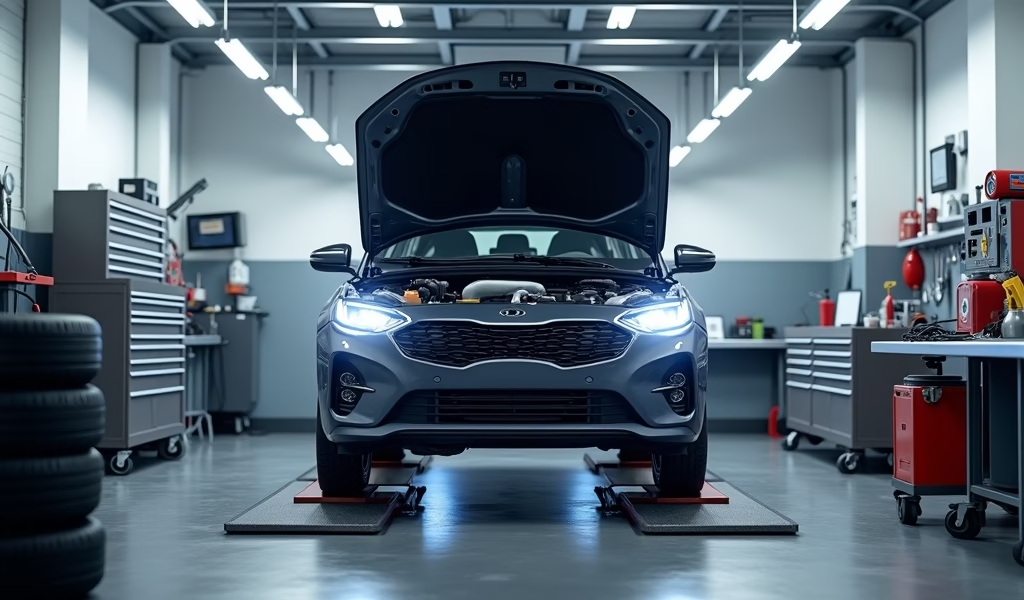Overview
This article explains why teen auto insurance costs are high and provides practical vehicle maintenance strategies that can improve safety while potentially lowering insurance premiums. It covers essential maintenance skills including fluid checks, tire care, understanding warning lights, and creating maintenance schedules that teens should master to become responsible drivers and more favorable insurance customers.
Table of Contents
- Understanding Teen Auto Insurance: Why It Costs So Much
- Regular Maintenance: Your Secret Weapon Against High Premiums
- Mastering Fluid Checks: Beyond the Oil Change
- Tire Care: The Foundation of Safe Driving
- Dashboard Warning Lights: What Your Teen Needs to Know
- Creating a Maintenance Schedule That Works
- Conclusion: Investing in Knowledge Pays Off
- Frequently Asked Questions
Understanding Teen Auto Insurance: Why It Costs So Much
Let’s face it – getting car insurance for teens often comes with a serious case of sticker shock. When my son turned 16 and got his license, our family premium nearly doubled overnight. I’ve been fixing cars for over 20 years, and even I was stunned by the numbers.
But as a mechanic, I understand why teen drivers face such high insurance costs. Statistics don’t lie – according to the CDC, teen drivers are nearly three times more likely to be in a fatal crash compared to drivers aged 20 and older. Insurance companies aren’t trying to punish your teen; they’re simply playing the odds.
What many parents don’t realize is that proper vehicle maintenance can actually help manage those sky-high auto insurance for teens costs. In my garage, I’ve seen countless preventable breakdowns that led to accidents – situations where better maintenance could have saved both the vehicle and potentially someone’s life.
Think of vehicle maintenance as an investment in your teen’s safety that can simultaneously protect your wallet. When insurance companies see a well-maintained vehicle with no mechanical claims, it tells them you’re a responsible customer. Some companies even offer specific discounts for preventive maintenance practices.
Regular Maintenance: Your Secret Weapon Against High Premiums
When it comes to auto insurance for teens, regular maintenance isn’t just about keeping the car running – it’s about safety, reliability, and potentially qualifying for insurance discounts. Many insurance providers offer lower rates for vehicles with documented maintenance records, though they don’t always advertise this fact.
Teaching your teen to properly care for their vehicle establishes habits that will benefit them throughout their driving life. I’ve seen 40-year-old drivers in my shop who never learned these basics, and they typically spend thousands more on repairs than those who maintain their vehicles properly.
Beyond the potential insurance benefits, regular maintenance prevents the kinds of mechanical failures that often lead to accidents. Failed brakes, blown tires, and overheating engines have caused countless collisions that proper maintenance could have prevented.
Here are the maintenance basics every teen driver should master:
- Understanding and following the manufacturer’s maintenance schedule
- Performing regular fluid checks and top-offs
- Maintaining proper tire pressure and tread depth
- Recognizing warning signs before they become major problems
- Keeping detailed maintenance records
Remember, it’s not just about saving money on auto insurance for teens – it’s about creating safer drivers. Let’s dive into the specific maintenance areas that matter most.

Mastering Fluid Checks: Beyond the Oil Change
Most folks know about oil changes, but your vehicle has several other critical fluids that need regular attention. Teaching your teen to check these fluids could prevent catastrophic engine damage and help maintain the value of their vehicle – both of which can impact auto insurance for teens rates over time.
Oil is the lifeblood of the engine. Show your teen how to check the oil level using the dipstick – park on level ground, wait about 10 minutes after shutting off the engine, pull the dipstick, wipe it clean, reinsert it, and check the level. The color matters too – clean oil is amber-colored, while dirty oil looks dark brown or black.
Coolant prevents overheating and freezing, depending on the season. Never check coolant when the engine is hot! The proper way is to look at the coolant reservoir when the engine is cool. Most have clear “min” and “max” lines that make checking easy.
Brake fluid is perhaps the most overlooked yet critical fluid. In my shop, I’ve seen dangerous brake failures from low fluid levels. The reservoir is typically transparent, allowing you to check the level without opening it (which can introduce air into the system).
Power steering fluid helps your teen maintain control of the vehicle. Low levels cause steering to become difficult, especially when parking or making tight turns. Most modern cars have a reservoir with clear markings for easy checking.
Transmission fluid failures can lead to repairs costing thousands. Many modern vehicles have sealed transmissions, but for those with dipsticks, teach your teen to check with the engine running and in park, following the manual’s specific instructions.
I once had a teenage customer whose engine seized completely because they never checked their oil. The repair cost over $4,000 – far more than any discount on best auto insurance for teens plans. A simple five-minute fluid check could have saved this family thousands.
Tire Care: The Foundation of Safe Driving
If there’s one maintenance task that directly impacts safety more than any other, it’s proper tire care. As someone who’s repaired vehicles after countless tire-related accidents, I can tell you that many were completely preventable with basic tire maintenance – a fact that insurance companies understand all too well.
Tire pressure should be checked monthly and before any long trips. Use a quality gauge (the ones built into gas station air hoses are notoriously inaccurate) and check when tires are cold. The correct pressure isn’t found on the tire itself – that’s the maximum rating. Instead, look for a sticker on the driver’s door jamb or in the owner’s manual.
Underinflated tires wear faster, reduce fuel economy, and can overheat on highways, potentially leading to dangerous blowouts. Overinflated tires provide a harsher ride and wear unevenly, reducing traction when you need it most – like during emergency braking situations that are more common with teen drivers.
Tread depth directly affects braking distance, especially on wet roads. The classic penny test works well – insert a penny with Lincoln’s head upside down into the tread groove. If you can see the top of Lincoln’s head, those tires need replacing. For winter driving, consider the quarter test instead, which provides a more conservative measurement.
Tire rotation is often overlooked but extends tire life significantly. Most front-wheel drive vehicles wear front tires about twice as fast as rear tires. Regular rotation (typically every 5,000-7,000 miles) ensures even wear and maximum tire life.
One young driver brought her car to my shop after sliding into a guardrail during a light rain. Her tires were so worn that they couldn’t channel water effectively, causing hydroplaning. The accident resulted not only in vehicle damage but also in substantially higher auto insurance for teens premiums for years afterward.
Dashboard Warning Lights: What Your Teen Needs to Know
Those little illuminated symbols on your dashboard aren’t just pretty light shows – they’re your vehicle’s way of communicating potential problems before they become roadside emergencies. Teaching your teen to understand and respond appropriately to warning lights can prevent expensive repairs and dangerous situations.
The check engine light is perhaps the most misunderstood. When it illuminates steadily, it indicates a problem that should be addressed soon but doesn’t require immediate action. When it flashes, however, it signals a severe problem that could damage the catalytic converter – stop driving as soon as safely possible.
Oil pressure warnings (typically an oil can symbol) require immediate attention. Unlike the check engine light, this one means “stop now” – continuing to drive could destroy the engine within minutes. I’ve rebuilt too many engines that could have been saved if the driver had just pulled over when this light appeared.
The battery/charging system light (usually a battery symbol) indicates a problem with your vehicle’s electrical system. While you can typically drive for a short time with this light on, the battery is discharging and will eventually leave you stranded. Head to a repair shop directly.
Brake system warnings are particularly critical for teen drivers to understand. This light may indicate low brake fluid, worn brake pads, or a system malfunction – all of which compromise your ability to stop safely. Modern vehicles may also have ABS (Anti-lock Braking System) warnings, which should never be ignored.
I recommend parents create a “warning light drill” with their teens. When a light appears, they should safely pull over, identify the light using the owner’s manual, and determine the appropriate next steps – whether that’s continuing to drive with caution or calling for roadside assistance.
Responding properly to warning lights isn’t just good car care – it demonstrates the kind of responsible behavior that insurance companies look for when pricing car insurance teenager policies. Preventive maintenance based on these early warnings often costs a fraction of what emergency repairs do.

Creating a Maintenance Schedule That Works
The most comprehensive maintenance knowledge won’t help if your teen doesn’t remember to use it. Creating a simple, realistic maintenance schedule can transform an overwhelming list of tasks into manageable habits that protect both your vehicle and your auto insurance for teens premiums.
Start by finding the manufacturer’s maintenance schedule in the owner’s manual. This is the bible of vehicle care, created by the engineers who designed the car. Most manuals include both normal and severe service schedules – and despite what you might think, most teen driving falls under “severe” due to frequent short trips and varied driving conditions.
Modern technology makes tracking maintenance easier than ever. Free apps like CARFAX Car Care or aCar can send reminders when service is due based on mileage or time intervals. Some even track expenses, which can help teens understand the true cost of vehicle ownership.
Create a glove box maintenance log for teens who prefer paper to digital. A simple notebook with dates, mileage, and services performed creates a valuable service history that not only guides future maintenance but can increase resale value and potentially help with insurance claims if mechanical issues arise.
Break maintenance into frequency categories to make it more manageable:
- Every fill-up: Check oil, inspect windshield for cracks, check tire pressure visually
- Monthly: Check all fluid levels, measure tire pressure with gauge, inspect lights
- Seasonally: Inspect belts and hoses, check battery connections, test wiper blades
- According to mileage: Oil changes, tire rotations, filter replacements, etc.
Consider creating maintenance “milestones” that align with your teen’s regular activities. For example, check tire pressure on the first Sunday of each month, or inspect wiper blades at the start of each sports season. Connecting maintenance to existing routines increases the chance they’ll remember.
I’ve seen impressive savings when families maintain detailed service records. One customer brought his daughter’s well-maintained Honda for pre-purchase inspection when she left for college. Their insurance agent reduced their auto insurance for teens premium after reviewing their meticulous maintenance history, citing reduced risk of mechanical failure.
Conclusion: Investing in Knowledge Pays Off
Teaching your teen proper vehicle maintenance isn’t just about saving money on auto insurance for teens – it’s about instilling lifelong habits that promote safety, responsibility, and financial awareness. The mechanical knowledge they gain now will serve them throughout their driving years.
Remember that insurance companies set high rates for teen drivers based on statistical risk. By helping your teen become the exception to those statistics through proper vehicle care, you’re not only potentially reducing premiums but also significantly decreasing their chances of breakdowns and accidents.
Regular maintenance isn’t complicated or mysterious – it’s simply about paying attention to your vehicle’s needs before small issues become big problems. The time you spend teaching these skills now represents an investment in your teen’s future independence.
In my decades as a mechanic, I’ve seen countless examples of how proper maintenance correlates with fewer accidents and longer vehicle life. The same attentiveness that leads someone to check their tire pressure regularly often translates to more cautious driving habits – exactly what insurance companies want to see in teen drivers.
So grab your owner’s manual, set a regular maintenance schedule, and use these teaching moments to bond with your teen driver. The knowledge you share now might just save them thousands in repair costs and insurance premiums down the road – and more importantly, it could keep them safer behind the wheel.
Ready to help your teen become a responsible vehicle owner? Start this weekend with a basic maintenance check together. The skills you share might be the most valuable driving lesson they ever receive.
Frequently Asked Questions
How much does auto insurance for teens typically cost?
Auto insurance for teens typically costs between $1,500 and $3,500 annually when added to a parent’s policy. Rates vary based on location, vehicle type, driving record, and available discounts.
Can good grades really lower my teen’s auto insurance rates?
Yes, many insurance companies offer “good student” discounts of 10-25% for teens who maintain a B average or better. This discount reflects statistical data showing that students with higher grades tend to have fewer accidents.
Does the type of car affect insurance rates for teen drivers?
Vehicle choice significantly impacts auto insurance for teens, with rates varying by up to 50% between different models. Midsize sedans and small SUVs with good safety ratings typically offer the most affordable premiums.
How long do accidents stay on a teen driver’s record?
Most accidents and violations remain on a teen’s driving record for 3-5 years, depending on state laws and the severity of the incident. The insurance premium impact typically decreases each year if no new incidents occur.
Are there special discounts available specifically for teen drivers?
Yes, many insurers offer teen-specific discounts including driver training completion, good student discounts, and usage-based insurance programs that monitor driving habits. Some companies also offer discounts for teens who sign a safe driving pledge.


Pingback: Auto Insurance for Teenagers: Save $100s - knowsyourcar.com
Pingback: How much is car insurance for a 16 year old? 5 Proven Maintenance Tips - knowsyourcar.com